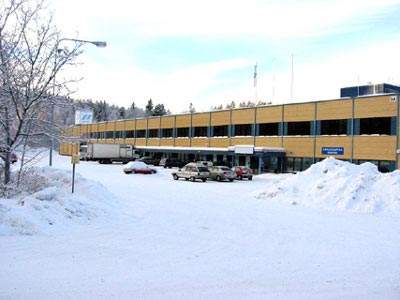The Kymijärvi biomass CFB (Circulating Fluidised Bed) gasifier started commercial operation in March 1998, producing about 230GWh in the first year of operation. The plant, which is owned by Lahden Lämpövoima Oy, uses opportunity fuels, including biomass, refuse fuels, shredded tyres and plastics. The CFB biomass gasifier is connected to a 138MWe PC boiler. Gasified biomass energy input is 40MWth to 70MWth, despite high moisture content of 50% to 20%.
The Kymijärvi project is in Lahti in Finland. It is a biomass CFB gasifier, intended mainly as a demonstration plant to show the new technology’s potential. The plant uses direct gasification of wet biofuel together with natural gas. The fuels are used directly in the existing coal-fired boiler. The boiler uses about 180,000t of coal each year, and equivalent to about 800GWh/y of natural gas. The maximum power capacity is 167MWe and the maximum district heat production is 240MW.
Low environmental impact
The driving force behind the plant was its lower environmental impact. The gasification of biofuels and co-combustion of gases in the coal-fired boiler offers several advantages. The most obvious is the recycling of CO₂. It also reduces SO₂ and NOx emissions. Most of the SO₂ emission reduction is due to the inherently low sulphur content of biofuels. The plant can also claim the unusually efficient use of biofuels and recycled refuse fuels. Even the use of existing power plant capacity, since the boiler needs only minor adjustments, can claim to be greener.
Despite its environmental priorities, the plant’s boiler does not use a sulphur removal system. The sulphur content of the coal is judged to be so low as to make it unnecessary. By contrast, NOx is reduced via plant design. The burners are provided with flue gas circulation and staged combustion to cut NOx emissions. The cooling effect of the low Btu, high-moisture product gas in the bottom part of the boiler helps reduce the amount of NOx given off. NOx emissions are also cut by the re-burning effect of ammonia. The limit values for the emissions are NOx 240mg/MJ (as NO2) and SOx 240mg/MJ.
The use of low chlorine coal helps give very low HCl emissions, given that the plant uses extensive amounts of rubbish. The plant also produces trace metals, but these are at a very low level. Despite using unusual fuels, the plant does not apparently suffer from unusual amounts of fuel deposits or high-temperature corrosion. This has been specifically tested for by Foster Wheeler. As well as all this, the plant has the economic advantages of low investment and operation costs. Since its operation began, the plant has managed a general availability of 82%. The highest monthly availabilities were 93%.
Gasification air
The plant uses a cyclone to separate the circulating bed material from the gas. The material is then sent to the bottom again. The hot gas flowing through the uniflow cyclone is cooled in the air preheater before it is fed into the main boiler. Simultaneously, the gasification air will be heated up in the air preheater before feeding it into the gasifier. The most unusual feature of the system is that the fuel is not dried, although the moisture content can be up to 60%. This means that heat production is very low.
The original gasifier fuel was biofuel, such as bark, wood chips, sawdust and uncontaminated wood waste. Biofuel typically contain 20% to 60% water, 40% to 80% combustibles and 1% to 2% ash. The plant uses both household and industrial waste as well. Shredded tyres and old railway sleepers have also been used. The use of these fuels has forced some modifications to deal with such unusual impurities as nails, metal wires and concrete. The fuel usage of rubbish is expected to increase. The refuse fuel is supplied by a municipally owned waste management company called Päijät-Hämeen Jätehuolto Oy, which began supplying fuel in 1997.
Plant history
The Kymijärvi plant was originally built as an oil-fired boiler in 1976 and modified for coal in 1982. In 1986, the plant had a gas turbine connected to the heat exchanger used to pre-heat the boiler feedwater. The maximum output of the turbine is 49MWe, although it is usually only employed at this level when the outside temperature is extremely cold.
Lahden Lämpövoima Oy is the sole owner of the plant. The city of Lahti owns 10% of the company, and the rest belongs to Fortum Oy (the utility company formerly known as IVO). Finnish power is in great demand during the winter months, because of the severe climate.




